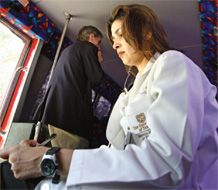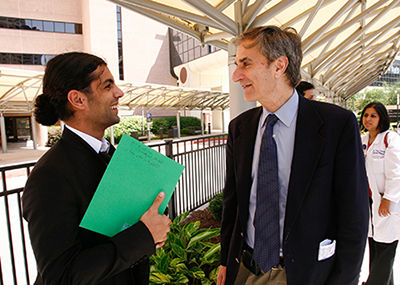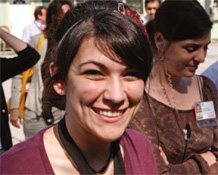Bus Rounds Reveals Home Hospice Care Landscape
As a bright red bus pulls away from the curb in front of MD Anderson, Eduardo Bruera, M.D., begins to share his extensive experience of patients in the palliative setting.


“The ‘f’ word should guide our care,” he tells passengers, then quickly adds, “that’s ‘f’ as in function. Whatever enhances a patient’s function is what counts.”
Twenty-four people — physicians, researchers, social workers, palliative care fellows, chaplains, nurses and a music therapist intern — strap two-way radios around their necks. And we’re off on the Texas Community Bus Rounds to visit three patients in the care of Jani Whitney, a registered nurse with Houston’s Memorial-Hermann Home Health.
Bruera, professor and chair of MD Anderson’s Department of Palliative Care and Rehabilitation Medicine, started the rounds 11 years ago. Since that time, hundreds of health care professionals from the Greater Houston area and farther away have benefited.
His goal is to help them learn to identify the complex medical, ethical, spiritual and psychosocial issues that patients face near the end of life.
Then, through visits to patients in home health care, he models effective ways of communicating with patients and caregivers that will improve understanding of their situations and needs.
Listen: To identify areas of suffering
As the bus moves toward north Houston and, then, from patient to patient, Whitney briefs participants on each case. We’re being trained to observe and, equally important, to listen.
“Counseling is about listening,” Bruera says. “The goal of visiting patients in home health care is to get them and their family members or caregivers to talk. A good therapist is there to listen, not to give advice. Talking allows them to get the pus out, to be like the dentist working on an abscessed tooth.”
He says one of the biggest problems is often avoided because it seems too sensitive to bring up. But the truth is, the cost of a patient’s long-term care can bankrupt a family.

Amber Zulfiqar, M.D., takes notes while Eduardo Bruera, M.D.,
discusses what he has learned working with hospice patients.
Photo: John Everett
“Financial fears and distress can affect quality of life,” Bruera says. “It’s very helpful to talk about these fears with the patient and the family, to let them know you understand. If you ignore it or pass over it, it can hurt them. Being supportive gives value to their situation. We need to address it because it’s an area of suffering.”
These insights have been invaluable for Amber Zulfiqar, M.D.
She joined Bus Rounds at the recommendation of a physician in palliative care at The Methodist Hospital in Houston and found the experience rich.
“We have a house call exposure during our training,” says Zulfiqar, a fellow in geriatrics and palliative medicine at Methodist.
“But seeing the cancer patients in their home settings helped me learn that prescribing pain medications is not enough. This experience has helped me take better care of my patients. I make it a point to ask them if they have any specific concerns — and to listen.”
Observe: What the eyes tell us
As we enter each home, Bruera also tells us to use our eyes.
- What do we see?
- Are there family photos?
- Is the house reasonably clean with crucial utilities, such as air conditioning?
- Is the patient dressed for the day or still in pajamas?
- Is there food in the kitchen? Are there signs of cooking?
- Is there a support system?
In other words, are the basic conditions of life being met?

Wadih Rhondali, M.D. (left), appreciates his time as an MD Anderson postdoctoral fellow, working in Eduardo Bruerra's department.
Photo: John Everett
For Wadih Rhondali, M.D., the experience was certainly eye-opening.
Colleagues at MD Anderson had recommended that the French psychiatrist in palliative care, and currently postdoctoral fellow at MD Anderson, participate in the Bus Rounds.
“They told me it was a different way to learn about patient care and to understand the daily reality of our patients in their home environment,” he says.
He found it was that, and much more.
“Instead of learning in the usual way, like in a classroom, I saw things you might never see working in a hospital or a cancer center,” he says.
“I can still remember watching one patient drink her glass of wine, the smell of another home. I also learned, or maybe it was a strong reminder, that when you take care of the patient, you also have to take care of the caregivers or everyone suffers.”
When he returns home, Rhondali knows what he learned will help him with his daily practice. He plans to share this teaching method with his colleagues — and maybe even start Bus Rounds in France one day.
Decide: Home health care or a facility
Bruera claims that what we often hear — “it’s better to die at home” — can be a myth. Some families prefer to place their loved one in a facility that can better cope with the physical aspects of care.
However, with the growing number of facilities, choosing is a challenge. He recommends that families ask the following questions when they visit facilities. He also suggests that to get the most honest answers, it’s best to show up unannounced.
- Does the facility have good security?
- Are there policies in place, such as making sure patients move out of their rooms or get some kind of physical activity every day?
- Does the staff know personal details about their patients without relying on the chart?
- Are patients dressed, groomed and clean?

Bus Rounds provides new insights for Hannah Gregory, who spent
several months at MD Anderson as a music therapy intern.
Photo: John Everett
Hannah Gregory, a music therapy intern at MD Anderson last spring, also joined the rounds. She’s familiar with hospice care in a facility, first from her mother, a hospice nurse, and second, from her grandmother, who has gone into hospice.
Gregory’s supervisor in MD Anderson’s Integrative Medicine Program, which provides music therapy to patients, recommended she participate on the basis of his own rich experience on the rounds.
“Although I’ve accompanied my mother over the years and already knew quite a bit about hospice care,” she says, “I saw in detail how home hospice works with cancer patients. I have a better insight into each diagnosis and more ideas of how I can use music therapy to better the quality of life for those who are nearing the end.”
Understand: What can and cannot be done
To provide the best care, Bruera says that health care workers need to understand where the patient is and what can be done for him or her. His recommendations surprised many participants.
“Don’t try to get a person in hospice care to stop smoking or recommend smoking cessation programs. They only have a limited time ahead of them, and they get some comfort from smoking.
“And at the end of life, it’s actually better to eat fast food,” he says to our amazement. “It’s fried and packed with proteins for energy. It no longer helps to eat the healthy diet of broccoli, grilled fish and salad.”
However, there are three things health care workers cannot give a patient at the end of life, he counsels:
- Money
- Family support
- Religious faith or some kind of spiritual connection
These needs can only be handled by the patient and family members, but they may be important to address.
We mull over these last thoughts as the bus rounds the corner and stops in front of MD Anderson. Conversations abound as participants descend, share contact information and prepare to return to their jobs — at Houston Hospice, The Methodist System, Baylor College of Medicine, Memorial Herman Hospital, The University of Texas Health Science Center at Houston and MD Anderson.
In evaluations over the years, health care professionals have given high marks to the program. They appreciate the opportunity these community experiences have provided. They value the suggestions for listening and coping, as well as the increased ability to observe family relationships.
They’ve also gained insights into what might be happening in the home environment and how that impacts patient and family.
Most important, they’re now using “function” to guide the management of their patient care.






















